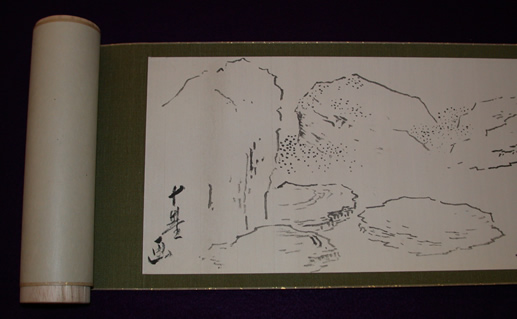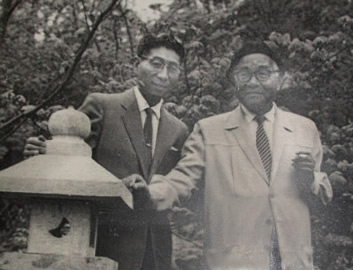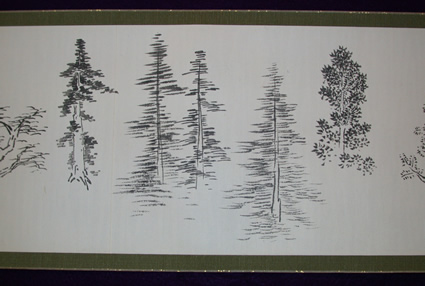
End of the scroll with his signature: “Juuki painted.”
Juuki Iida was selected by the Tokyo Metropolitan Park Department to help realize the Seattle Japanese Garden in the spring of 1960. He took the space designated in Washington Park and infused it with his deep understanding of Japanese gardens.
He brushed this scroll at leisure during his stay in Seattle and then gave it to Richard Iwao Yamasaki, who worked closely with him. The scroll reveals the essentials of the Japanese garden: trees, water and rocks, which, when brought together in quiet and harmony, grow, age, and become natural.

James Fukuda with Juuki Iida (on right)
Remembering Juuki Iida: Dedication Ceremony Remarks by Richard Yamasaki
During Juuki Iida’s first trip to Seattle in 1959, Jim Fukuda, who was with the Japan Consulate-General, called me and asked if I would like to meet Iida. He said that Iida was seeking workers for the future Seattle Japanese Garden, and Jim had spoken to him about my interest and work with rocks and stones. As a result of that meeting, Iida selected me and my crew. Being Nisei, a second-generation Japanese born in America, I knew very little about Japanese gardens. I discussed the project with my brother and my crew and decided to accept, especially since memories of the war had subsided.
My education on Japanese gardens began then. Iida would call me over, ask me to sit by him and listen to his views on what this Seattle garden would be like. Because of the language barrier, I could not ask questions in Japanese, so I just listened and watched. In the evenings he would expand more on his vision of the garden.
There were two things that drew me to Iida sensei, and he became a mentor to me. First, he continued to help me see what he was creating, a Japanese garden in a foreign setting, but with strict application of certain Japanese principles, such as shizensa (naturalness) and sono mama no susumu sugata, or the way natural elements age and spread. Second, he was willing to listen as I took him to places like Moses Lake and the North Cascades as I explained what the Japanese who left Japan and settled in the Seattle area had accomplished.
Since Iida sensei’s stay was so short, he invited me to see him in Tokyo, which I did in 1967, when my father who lived in Okayama fell ill with a stroke. Iida sensei sent a car for me and took me to see gardens around Tokyo. This visit left me with deep and lasting memories and a lifelong desire to study and understand his teachings.
This is why today Fumi and I are so pleased that this scroll, which he painted in ink during his evenings at the Holland Hotel in Seattle, and which he gave me in 1960, may now be seen by those who visit and work in the Seattle Japanese Garden. Fumi and I have held it for so many years. It now becomes, along with his creation, and his concern for our ability to maintain the garden, Juuki Iida’s legacy to all of us. Thank you.

A Chronology for the Life of Juuki Iida
Compiled by Julie Coryell
Born 1890.
1918. Opened his own gardening office. He regretted the cutting of trees as directed by his teacher, and was influenced by Meiji era plantings of maples and oaks. Iida practiced the traditional arts of Ikebana, Bonsai, and Shodo, as well as calligraphy. Dick Yamasaki adds: “As a young man, Iida was hired to remove woodlands for development. Later, he came to value tree groves, to preserve, restore and enhance them wherever possible.”
November 29, 1959. First trip to Seattle. Tokyo Metropolitan Park Director Tatsuo Moriwaki had visited Seattle in 1958 to study the site, and headed the design team of Iida, Nobumasa Kitamura, Iwao Ishikawa, Naotomo Ueno, and Chikara Itou. Iida presented the design to the Arboretum Foundation with Consulate General officials Tsuge and Fukuda. Iida visited garden sites and recommended William Yorozu as prime contractor for plants, Richard Yamasaki for stone setting, and Kei Ishimitsu for structures. He flew to Washington, D.C. for several days, then returned to mark the stones at Mt. Bandera for installation in the spring of 1960.
March 7, 1960. Returned to Seattle with Nobumasa Kitamura and “27 pages of revised plans.” With seventy percent of the grading and rough work complete and most of the rocks ready to set, Kitamura worked around the shoreline, middle island and suhama (cobble beach), and Iida concentrated on the waterfall, cascade, and pool areas. During his stay, Iida brushed the scroll on five joined lengths to illustrate trees, a water feature with stone slab bridge, and rock arrangements. Iida gave the scroll to Dick Yamasaki when he returned to Japan after the June 5, 1960 opening of the garden.
July 27, 1973. Returned to Seattle for a 15-day visit.
August 9, 1977. On this, the 49th day after his death, a Buddhist memorial service for Juuki Iida was held on the woodland knoll in the Japanese Garden.
Our deepest thanks to Richard Iwao Yamasaki and Fumiko Yamasaki, whose generosity in donating the Iida Scroll to the University of Washington Botanic Gardens will allow countless individuals to enjoy and study the scroll for years to come.
Special thanks to the following individuals:
- The Honorable Kazuo Tanaka, Consul General of Japan
- Vice Consul Noriyasu Yoshinaka, Consulate General of Japan
- Mr. Akira Takeda, Senior Assistant for Information and Cultural Affairs, Consulate General of Japan
- Professor David J. Mabberley, Director, University of Washington Botanic Gardens
- Dr. Jesse Hiraoka and Dr. Louise S. Kikuchi
- Julie Coryell and Seelye Martin
- Kenichi and Takako Matsuoka
- Mineo and Kazuko Matsuoka
- Masatsugu Kawasaki, Tessai-Do Gallery, Kyoto, Japan
- Tom Blue, Plasteel Frames, Seattle